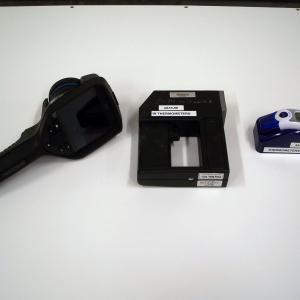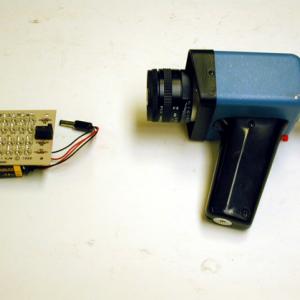College of Liberal Arts & Sciences
4A10.80 - IR Thermometers
The FLIR camera is the primary for this demonstration and can show a color scale and associated temperature when scanning. IR temperatures can also be taken with the Raytek and the standard fever thermometer. Note that the fever themometer has a very limited temperature range.
You can "see in the dark" with the black and white camera or the IR viewer when using the IR diode illuminating array as the chip in the camera and the viewer is sensitive in the near IR.
The bolometer is an ancient 1980 device used for detecting radiation from nuclear particles striking the detector. It was designed for use at 4.2 Kelvin and has an outer jacket that was filled with liquid nitrogen and then an inner jacket that contained liquid helium to cool this device to its operating temperature. The information we have been able to gather on this detector suggests that this has a thermopile type detector in it.
- Emil Melander, Jesper Haglund, Matthias Weiszflog, and Staffan Andersson, "More than Meets the Eye – Infrared Cameras in Open-Ended University Thermodynamics Labs", TPT, Vol. 54, #9, Dec. 2016, p. 528.
- Jochen Kuhn and Patrik Vogt, "Diffraction Experiments with Infrared Remote Controls", TPT, Vol. 50, #2, Feb. 2012, p. 118.
- Charles Xie and Edmund Hazzard, "Infrared Imaging for Inquiry-Based Learning", TPT, Vol. 49, #6, Sept. 2011, p. 368.
- Michael Vollmer, Klaus-Peter Möllmann, Frank Pinno, and Detlef Karstädt, "There Is More To See Than Eyes Can Detect", TPT, Vol. 39, #6, Sept. 2001, p. 371.
- Erin E. Pursell and Richard Kozlowski, "Infrared Radiation: Herschel Revisited", TPT, Vol. 38, #9, Dec. 2000, p. 559.
- William Shanks, Edward J. Carlone, and William Blunk, "A Blue-Hot Giveaway for Your Group", TPT, Vol. 20, #3, Mar. 1982, p. 181.
- Barry N. Lightfoot, "Infrared Telescope", TPT, Vol. 17, #2, Feb. 1979, p. 132.
- Dudley Williams, "Infrared Radiation", TPT, Vol. 1, #5, Nov. 1963, p. 212.
- N. A. Gross, M. Hersek, and A. Bansil, "Visualizing Infrared Phenomena With a Webcam", AJP, Vol. 73, #10, Oct. 2005, p. 986.
- Sun-Chong Wang, Jun-Wei Zhou, O. Redi, H. H. Stroke, N. Coron, and J. Leblanc, "Neutrino Mass and Low-Temperature Calorimetry", AJP, Vol. 66, #7, July 1998, p. 574.
- Sol Wieder and Edmond Jaoudi, "Autobalancing Radiometer", AJP, Vol. 46, #9, Sept. 1978, p. 935.
- R. M. Fuller, "Greenhouse Effect Study Apparatus", AJP, Vol. 41, #3, March 1973, p. 443
- Donald G. Mooney, "The Amateur Scientist: Seeing Infrared", Scientific American, Vol. 266, #3, Mar. 1992, p. 112.
- C. L. Stong, "The Amateur Scientist: A Simple Laser Interferometer, an Inexpensive Infrared Viewer and Simulated Chromatograms", Scientific American, Vol. 226, #2, Feb. 1972, p. 106.
- Tom Gibson, "Seeing in the Dark", How it Works, Science Supplement, Spring 2000, p. 248 - 255.
- Borislaw Bilash II and David Maiullo, "Hear the Light", A Demo a Day: A Year of Physics Demonstrations, p. 317.
- Martin C. Sagendorf, "45. Infra-Red [Night] Vision - A Demonstration", Physics Demonstration Apparatus, 2009. p. 138 - 141.
- Martin C. Sagendorf, "42. What You Can't See - Infra-Red", Physics Demonstration Apparatus, 2009. p. 125 - 130.
- Gorazd Planinsic, "A Photoshoot for Food and Drink: Camera Sees More Than You Think", Physics Education, Vol. 39, #1, Jan. 2004, p. 32.
- Brian Jones and Matt Fackelman, "Infrared Images: Not Only Does the Camera Add Ten Pounds...", Don't Forget the Duct Tape: Little Shop of Physics, p. 61 - 64.
- Ron Hipschman, "Recipe No. 126. Low Frequency Light", Exploratorium Cookbook II, 1980, p. 126-1 - 126-4.
- Rick Beyer, "Surfing Safari", The Greatest Science Stories Never Told, p. 168 - 169.
- Infrared Thermometer Instruction Manual, Wellkang Ltd.
Disclaimer: These demonstrations are provided only for illustrative use by persons affiliated with The University of Iowa and only under the direction of a trained instructor or physicist. The University of Iowa is not responsible for demonstrations performed by those using their own equipment or who choose to use this reference material for their own purpose. The demonstrations included here are within the public domain and can be found in materials contained in libraries, bookstores, and through electronic sources. Performing all or any portion of any of these demonstrations, with or without revisions not depicted here entails inherent risks. These risks include, without limitation, bodily injury (and possibly death), including risks to health that may be temporary or permanent and that may exacerbate a pre-existing medical condition; and property loss or damage. Anyone performing any part of these demonstrations, even with revisions, knowingly and voluntarily assumes all risks associated with them.

